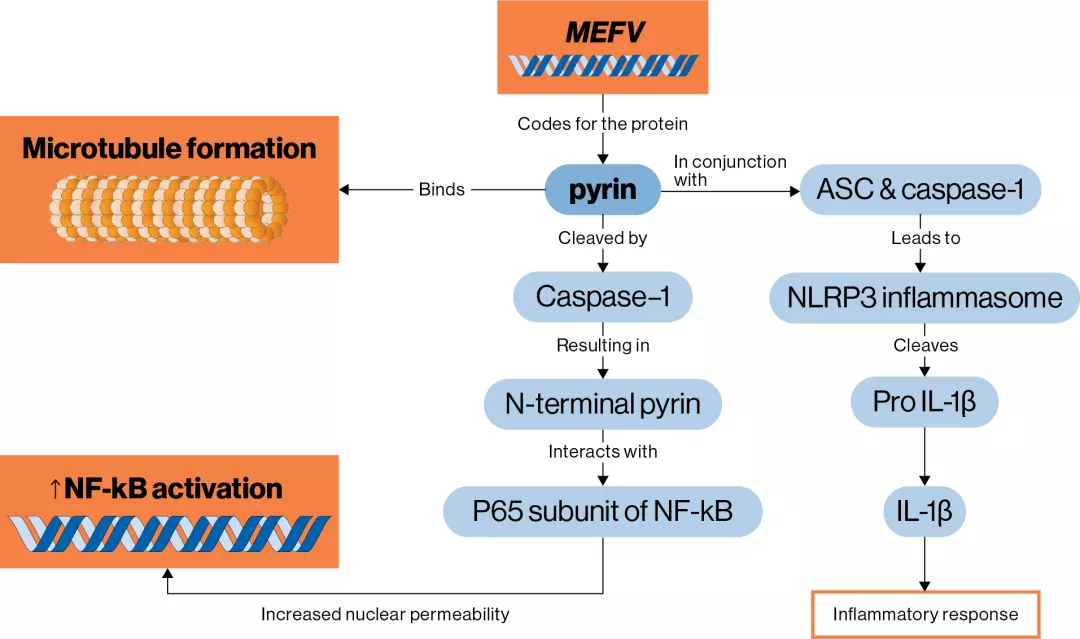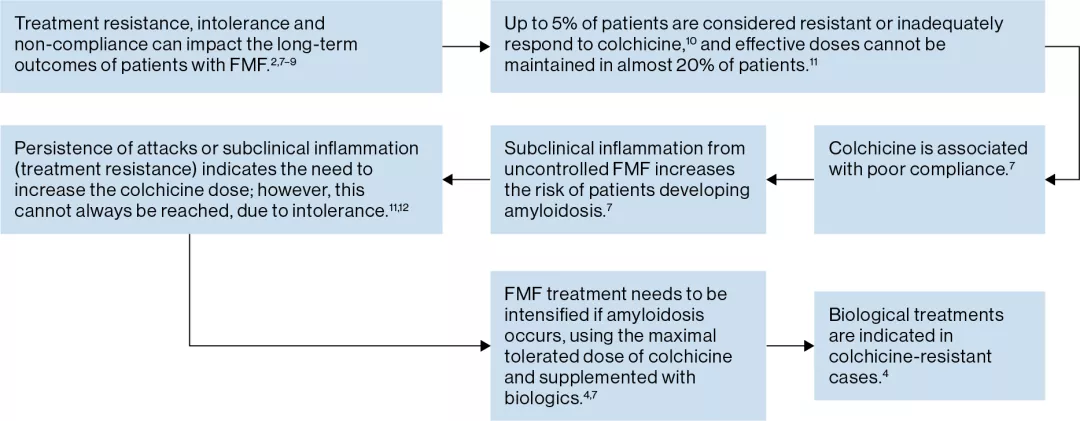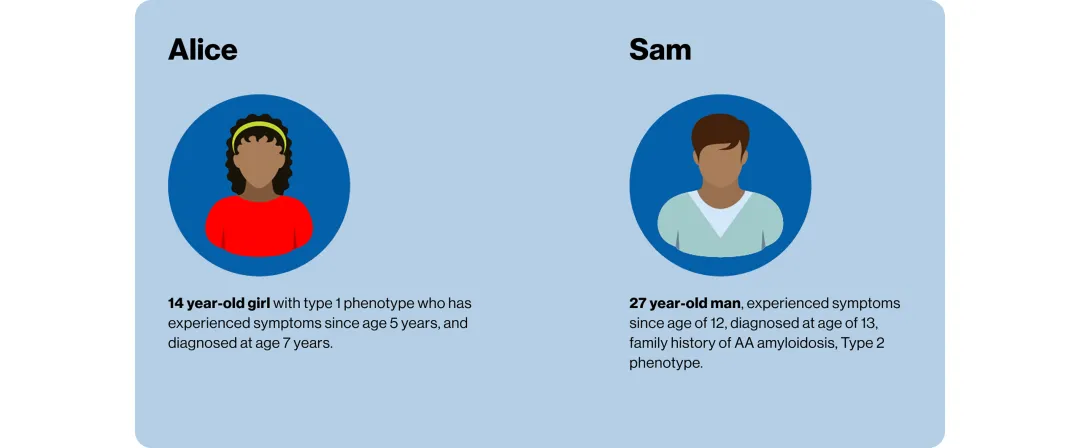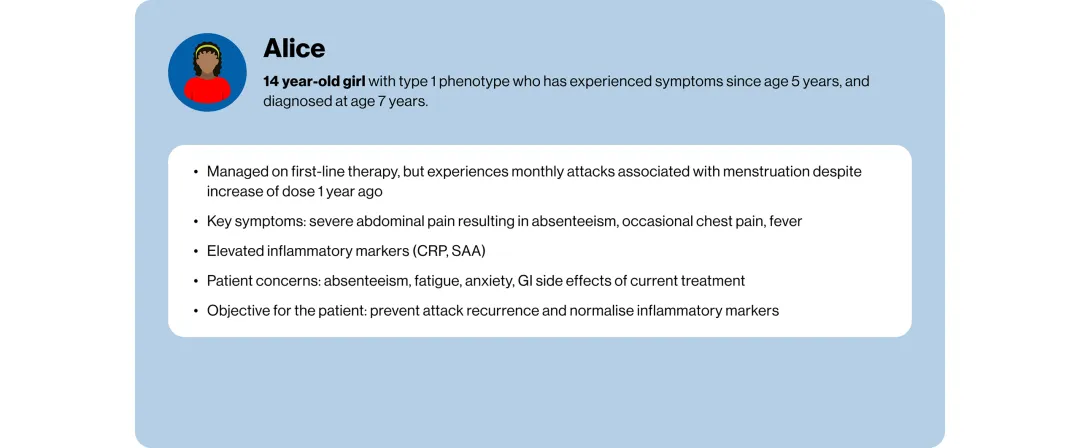

Familial Mediterranean fever (FMF)
FMF is a rare hereditary autoinflammatory disease caused by mutations in the Mediterranean fever (MEFV) gene.1
Find out what causes this disease, who it affects, how it presents and the goals of treatment by clicking on the tabs below.
Global prevalence is highest in Turkey at between 1:150 and 1:10,0002
The second most frequently affected ethnic group is Armenians. Prevalence is reported at 1:5002
Patients usually experience their first attack before their twentieth year1
Patients >12 years at the onset of FMF have a reduced frequency of fever attacks than younger patients5
Patients under the age of 5 years at the onset of FMF experience more severe attacks5
Pericarditis (<1% patients)
Scrotal swelling
Myalgia
Erysipeloid skin rash
Why does FMF occur?
FMF is an autosomal recessive hereditary disease.2 It occurs due to a mutation in the Mediterranean fever (MEFV) gene on the short arm of chromosome 16.2
The MEFV gene encodes a protein called pyrin, which regulates apoptosis, inflammation and cytokines. It is mainly expressed in neutrophils, eosinophils, dendritic cells and fibroblasts.2
How does MEFV mutation cause FMF?
It is believed that the mutated pyrin molecule is not able to carry out its normal regulatory mechanisms and does not suppress the production of IL-1β, normally involved in the inflammatory response.2
Uncontrolled release of IL-1β results in an inflammatory response.2
The role of pyrin in FMF is illustrated below.3

Figure adapted from Petrushkin H, et al. 2015.3
Who does FMF affect?
FMF affects 150,000 patients worldwide.1
It is most commonly observed amongst ethnic groups originating in the Mediterranean region.1 It primarily affects Jewish, Armenian, Turkish, and Arab populations,1,2 although patients from different ethnicities, such as Japan4 and Italy1 are being increasingly recorded.
Main clinical features of FMF during attacks are:1

Recurrent short-term fever attacks

Abdominal pain (95% of patients)

Arthritis (>50% of patients)

Pleuritis (40% of patients)
Less frequently:1
FMF patients can be divided into three distinct phenotypes:5
Type 1
Acute attacks of fever + classical symptoms of painful serositis and arthritis
Type 2
Kidney amyloidosis, without other symptoms of FMF and without fever attacks
Type 3
Patients with two mutations of the MEFV gene, without fever, other symptoms of FMF, or amyloidosis
How long do febrile attacks normally last for?
The first attack appears before the age of 20 years in more than 85% of patients.1 Typical attacks last for between one and three days and can occur in frequency from days to years.6 In between the attacks, patients are completely symptom-free.1
What is the outcome if FMF is not effectively controlled?
Untreated or inadequately treated patients experience persistent attacks and subclinical inflammation. These patients are at risk of developing amyloidosis, a major cause of morbidity and mortality due to organ failure.1,2
FMF causes significant reduction in quality of life due to the effects of fever attacks and subclinical inflammation in the period between attacks.2
The goal of treatment for patients with FMF
To reach complete control of unprovoked attacks, minimise subclinical inflammation in between attacks, which may lead to long-term complications, and improve quality of life5,7,8

Please refer to the Summary of Product Characteristics of relevant products before a prescribing decision is made.
What do patients with FMF look like in practice?
View the fictional patient profiles below and find out what types of patients clinicians are presented with in clinic, and what the main objectives are for their care. Individual experiences may vary.



ASC, apoptosis-associated speck-like protein; CRP, c-reactive protein; eGFR, estimated glomerular filtration rate; FMF, Familial Mediterranean fever; GI, gastrointestinal; IL-1β, interleukin-1 beta; MEFV, Mediterranean fever gene; NF-kB, nuclear factor kappa B; NLRP3, NOD-, LRR- and pyrin domain-containing protein 3; SAA, serum amyloid A.
References
Wang DQH, et al. J Genet Syndr Gene Ther 2014;5(5):1–11.
Sari I, et al. Eur J Rheum 2014;1:21–33.
Petrushkin H, et al. Ocul Immunol Inflamm 2015;24:1–9.
Özen S, et al. Front Immunol 2017;8. DOI:10.3389/fimmu.2017.00253.
Maggio MC, Corsello G. Ital J Pediatrics 2020:46:7.
Genetics Home Reference. Familial Mediterranean fever. Available at: https://medlineplus.gov/genetics/condition/familial-mediterranean-fever/ [Accessed March 2025].
Özen S, et al. Ann Rheum Dis 2016;75(4):644–651.
Salman RB, et al. J Clin Rheumatol 2022;28(1):e77–e80.
Melikoglu MA, et al. Int J Rheum Dis 2017;20(12):2118–2121.
Özen S, et al. Semin Arthritis Rheum 2017;47(1):115–120.
Satis H, et al. Turk J Med Sci 2020;50:1337–1343.
Kacar M, et al. J Inflamm Res 2020;13:141–149.
UK | March 2025 | FA-11324197
Adverse events should be reported. Reporting forms and information can be found at www.mhra.gov.uk/yellowcard.




